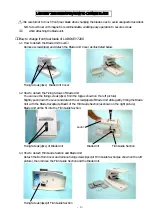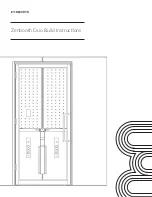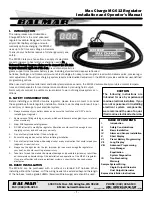
Lake Shore Model 370 AC Resistance Bridge User’s Manual
2.7.2
Excitation vs. Signal-to-Noise
Since excitation power has such a dramatic effect on self-heating, why doesn’t everyone use the lowest excitation range?
The answer is noise, or more appropriately signal to noise. Noise from a variety of sources affects the small signals used
to make bridge measurements. Lowering excitation makes the signals even smaller but unfortunately doesn’t decrease
the noise. The noise sources described in Paragraph 2.5 are a fact of life. Even with careful installation their effects
cannot be reduced below a few microvolts. That is why the Model 370 does not have voltage excitation below 2
μ
. The
goal of most experiments is to choose an excitation that is the best compromise between self-heating and signal to noise.
The monitor output (Paragraph 3.6) can be used to view the amplified signal coming into the input of the Model 370.
Seeing the amplitude and frequency of noise at this point can help identify its sources as an aid in troubleshooting.
2.7.3
Signal-to-Noise vs. Measurement Bandwidth
The noise sources described Paragraph 2.5 combine to reduce the resolution of small signal measurements. There are
some common themes in the way noise interacts with measurements, noise affects worsen when signal size decreases,
when resistance increases and when bandwidth increases. Excitation is limited by self-heating and cannot always be
increased to create larger signals. Resistance can seldom be changed because it is the quantity being measured. That
leaves bandwidth to overcome signal to noise and improve resolution.
If noise cannot be reduced at its source it has to
be averaged out.
Reducing measurement bandwidth can help with nearly every continuous noise source including
induced noise at discrete frequencies, 1/f circuit noise and broadband thermal noise. Unfortunately there is a price to pay
and it is time.
All small signal measurement instruments include some type of bandwidth limiting to improve resolution. The band
limiting capabilities are so closely tied to instrument performance that most resolution specifications are given at a
specified time constant or bandwidth. The Model 370 uses a combination of analog band pass and low-pass filters and
digital averaging. The phase sensitive detector (PSD) in the Model 370 is a very narrow band pass filter. The output of
the PSD is run through an analog low-pass filter with 200 ms time constant to give an equivalent DC voltage. The user
cannot change these two filters making the widest bandwidth possible on the Model 370 200 ms. Once the DC voltage is
digitized the user can choose additional digital averaging to reduce bandwidth further and increase resolution.
Unfortunately, reducing bandwidth increases time constant and settling time slows the instrument response to real
changes in resistance; because those changes are averaged along with the noise. Probably the most frustrating aspect of
using a resistance bridge is realizing that when noise can be as large as the signal being measured it takes a lot of time
averaging to separate the two. Back to the thermal noise example above, if the noise voltage of a 100 k
Ω
resistor at room
temperature using a 1 second filter is approximately 80 nV PP, reducing it by a decade to 8 nV PP would require
increasing time constant 100 s (bandwidth to 10 ms). This reality is unappealing to most investigators because actual
changes in resistance that take less than a few hundred seconds could easily be missed.
2.8
MODEL 3716/L and 3708 SCANNER
The Model 3716 /L Scanners expand the input capability of the Model 370 from 1 to 16 channels. The 3716L provides
different measurement circuitry to allow better, low resistance measurements. The 3708 expands the input capability of
the Model 370 from 1 to 8 channels and provides an even lower noise, low resistance measurement. Refer to section 1.1
for details on the differences between the available scanners.
The scanners are made up of relay switches for current and voltage signals of each channel, a times 100 amplifier for the
voltage signals going back to the Model 370 and necessary control circuits. The scanner is housed in a separate shielded
enclosure so that it can be placed near the test Dewar. Power for the scanner is taken directly from the regulated DC
power supplies of the Model 370. Mounting bracket and 10 foot cables to join the Model 370 are included with the
scanner. Mating connectors are supplied for the scanner inputs.
All scanner circuits including its power supplies and enclosure are referenced to the isolated measurement common in
the instrument. This arrangement protects low level measurement signals from noise. All inactive input leads are shorted
to common to minimize noise pickup. Special care must be taken during installation to maintain low noise operation.
Refer to Paragraph 3.5 for scanner installation.
The Model 370 can read any of the 16 scanner channels, one at a time. Channel change can be done manually or with the
autoscan feature. The instrument stores input setup information for each channel and will use the appropriate setup for
each channel when selected. Refer to Paragraph 4.8 for scanner operation.
Theory of Operation
2-13
Содержание 370
Страница 22: ...Lake Shore Model 370 AC Resistance Bridge User s Manual 1 12 Introduction This Page Intentionally Left Blank ...
Страница 60: ...Lake Shore Model 370 AC Resistance Bridge User s Manual 3 16 Installation This Page Intentionally Left Blank ...
Страница 106: ...Lake Shore Model 370 AC Resistance Bridge User s Manual 5 12 Advanced Operation This Page Intentionally Left Blank ...
















































